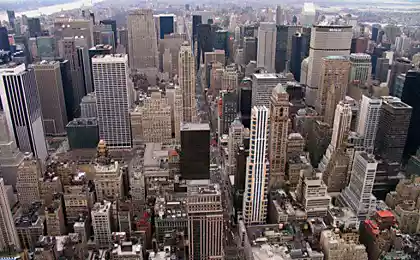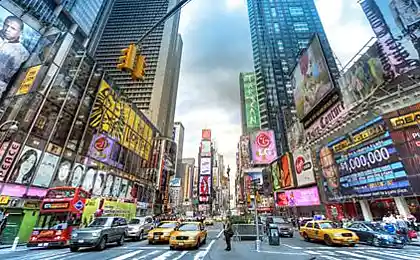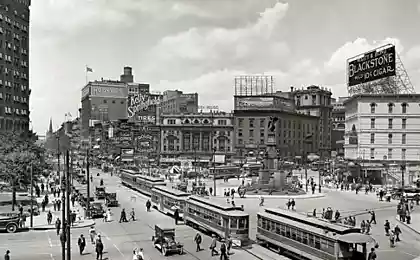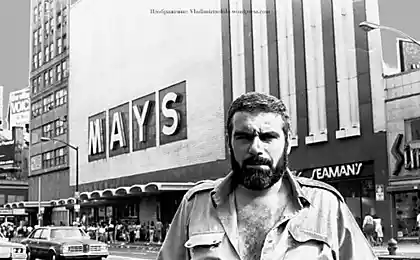677
The most wasteful metropolis in the world
I live, quite happily, in the dirty and wasteful metropolis of the world. It is densely populated, is steadily aging, consumer utopia, where we buy and throw away, the staggering amount of things. Where any faucet, toilet or pipe that is constantly leaking in our apartments. Where always included garland commercial inviting lights. Where an army of gas-guzzling cars still clog the roads. I, along with my twenty million or so neighbors, help new York to use more energy to suck more water and dump more solid waste than any other metropolis.
This is a great achievement, considering that in the world there are at least 26 other cities, which, according to a new study published rabotah the National Academy of Sciences, consume 9 percent of the electricity of the planet, used by 10 percent of its petrol, creating 13% of its garbage. In 2010 in the world there were 27 Metropolitan areas. In 2020, if the UN projections are correct, there will be about 40 (in 1970 was only 8). According to the study, new York more wasteful, per capita, than all of them put together.
"In new York city is home to 12 million people less than in Tokyo, but it uses more power in total: the equivalent of one supertanker of oil every 1.5 days," says study author Chris Kennedy, Professor of civil engineering at the University of Toronto. "When I saw it I thought it was just unbelievable." Mainly because new York uses more gasoline and heating and industrial fuel, than Tokyo.
And just see how much more waste per capita creates new York than any other large metropolis:
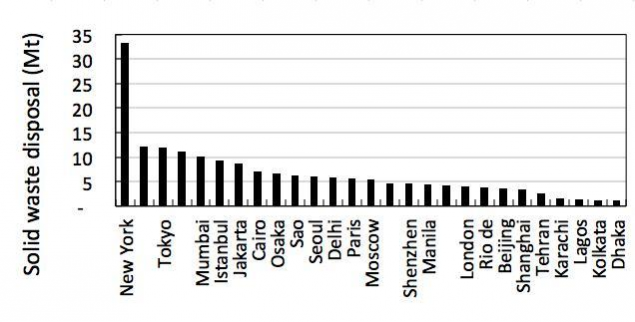
Image: Kennedy, NAN
New York throws more than 33 million tons of waste per year. The next closest competitor — Mexico city (mark is missing in the chart above), which generates unexpected 12 million tons of garbage, followed by Tokyo, which, again, live tens of millions of potentially generating debris of its citizens. The average new Yorker uses twenty times more energy than someone in Calcutta, and creates 15 times more solid waste. I'll say it again: new York is a very dirty metropolis.
The term "metropolis" is usually used to describe agglomeration, home to more than 10 million people. According to this calculation, new York meet the definition. He was, according to some estimates, the first metropolis, whose population exceeded 10 million in 1950. Now there are approximately 20 million people who speak 800 languages, 6,000 square miles (10,000 square metres), which comprise the largest Metropolitan area of the city. And we create a mess.
This old stereotype about new York is preserved to this day, despite its careful buffering in the commercial platform for the generation of the Millennium: dirty, strewn with rubbish, lit by neon lights, congested, and constantly vydyhaemoy steam, heat and exhaust emissions from each industrial openings. It is necessary to understand and to keep in mind. It's probably closer to the manifestation of the true environmental nature of the city than its modern image as a center of artisanal food and sleek luxury apartments.
Now is a good time to start thinking about the consequences of living in giant cities that we love now because Age of the Metropolis, in the end. Migration to urban areas is well documented; in the past decade, people flock to the cities. As of last year, 54 percent of the world's population lives in cities. By the end of the decade, three out of every five people on Earth will live not just in cities but in Metropolitan areas, which we hope will ultimately function slightly more balanced than new York now.
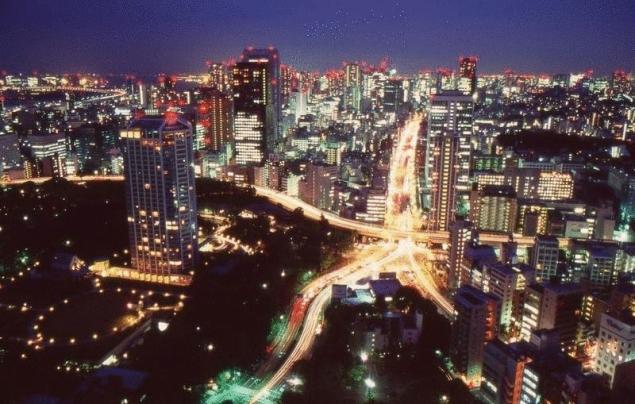
Transportation Tokyo night. Photo: Naillord, Wikimedia
A new study by the NAS reveals some details of the "metabolic metropolis", namely how energy and resources move through the city. It is, as the authors note, "a great achievement". It turns out that these massive centers of humanity in fact, at the moment, consume more energy than their non-mega counterparts of civilization.
This is important because prominent urbanists and contemporary ekologiia that city life will reduce the production of waste and energy consumption. It is, of course, is fraught with the potential to do just that: when people live closer to each other, less energy spent on transportation of people and goods. Public transportation can replace cars. More intensively used public space. It's cleaner, more efficient system.
The effectiveness and advantages of a dense population are in constant interaction with our aspiration to consumption, and new York these aspirations are easily implements.But just the creation of densely populated cities does not guarantee sustainability, highlighted by the work of Kennedy.
"With the growth of cities social characteristics such as GDP, innovation, and crime, growing per capita, while the requirements of the system infrastructure (meters, pipes or wires) decrease per capita," said Kennedy to me via e-mail. "With regard to sustainability or environmental impact of cities, we can say that there is a tradeoff between the influence of wealth and influence the efficiency of infrastructure".
The effectiveness and advantages of a dense population are in constant interaction with our aspiration to consumption, and new York these aspirations are easily implements. Research, Kennedy shows that when cities get richer, like new York, they become wasteful. "A possible interpretation of the obtained results for cities is that the wealth effect dominates in relation to the production of solid waste, consumption of electricity and gasoline (all at a higher level than the global average)," he said, "but in relation to the total direct energy consumption both influences are equal". Cities stimulate innovation and wealth creation.
Yes, but this, in places like new York, leads to greater consumption. We can hear about the countless and noble initiatives of the balance of new York, or how to find the city's future green life, but also remember that these leaky pipes, taxis, flooded the Brooklyn bridge, filled with tenants skyscrapers, and a package for a trash bag, which you pull down from your third floor without Elevator, not getting anywhere, it all has an impact on the environment.
Kennedy says, "Yes, our results in the cities opposite to the idea that cities currently use energy more efficiently, although perhaps this will change in the future." It is also important that the study indicates that some cities can boast of very stable trends.
Good urban design and better public transport system in Tokyo makes it a model among cities in the use of energy. He also does excellent work in repairing its leaking pipes. Moscow, which according to Kennedy is the only true competitor to the new York waste per capita and is the only city that uses more energy, has a complex system of heat distribution; it uses waste heat from its power stations to heat their homes. And in London, "where the proportion of solid waste in landfills in the United Kingdom fell from 80% in 2001 to 49% in 2010," according to the report, the tax on waste disposal has significantly reduced the production of waste.
And none of this speaks to the fact that large cities still do not promise a more efficient, less wasteful future. "Our data confirm the established understanding that compact cities are the best choice", told me Kennedy.
We just need to learn to better design, operate and regulate them. For cities of the future, like it or not, and they give you the opportunity to set up the society to effectively prepare for a warmer, more turbulent world with lack of resources. We just need to make their flows of energy and waste more like Tokyo and less like new York city... posted
Author: Brian Merchant
P. S. And remember, only by changing their consumption — together we change the world! ©
Source: www.vice.com/ru/read/the-worlds-most-wasteful-megacity-999
This is a great achievement, considering that in the world there are at least 26 other cities, which, according to a new study published rabotah the National Academy of Sciences, consume 9 percent of the electricity of the planet, used by 10 percent of its petrol, creating 13% of its garbage. In 2010 in the world there were 27 Metropolitan areas. In 2020, if the UN projections are correct, there will be about 40 (in 1970 was only 8). According to the study, new York more wasteful, per capita, than all of them put together.
"In new York city is home to 12 million people less than in Tokyo, but it uses more power in total: the equivalent of one supertanker of oil every 1.5 days," says study author Chris Kennedy, Professor of civil engineering at the University of Toronto. "When I saw it I thought it was just unbelievable." Mainly because new York uses more gasoline and heating and industrial fuel, than Tokyo.
And just see how much more waste per capita creates new York than any other large metropolis:

Image: Kennedy, NAN
New York throws more than 33 million tons of waste per year. The next closest competitor — Mexico city (mark is missing in the chart above), which generates unexpected 12 million tons of garbage, followed by Tokyo, which, again, live tens of millions of potentially generating debris of its citizens. The average new Yorker uses twenty times more energy than someone in Calcutta, and creates 15 times more solid waste. I'll say it again: new York is a very dirty metropolis.
The term "metropolis" is usually used to describe agglomeration, home to more than 10 million people. According to this calculation, new York meet the definition. He was, according to some estimates, the first metropolis, whose population exceeded 10 million in 1950. Now there are approximately 20 million people who speak 800 languages, 6,000 square miles (10,000 square metres), which comprise the largest Metropolitan area of the city. And we create a mess.
This old stereotype about new York is preserved to this day, despite its careful buffering in the commercial platform for the generation of the Millennium: dirty, strewn with rubbish, lit by neon lights, congested, and constantly vydyhaemoy steam, heat and exhaust emissions from each industrial openings. It is necessary to understand and to keep in mind. It's probably closer to the manifestation of the true environmental nature of the city than its modern image as a center of artisanal food and sleek luxury apartments.
Now is a good time to start thinking about the consequences of living in giant cities that we love now because Age of the Metropolis, in the end. Migration to urban areas is well documented; in the past decade, people flock to the cities. As of last year, 54 percent of the world's population lives in cities. By the end of the decade, three out of every five people on Earth will live not just in cities but in Metropolitan areas, which we hope will ultimately function slightly more balanced than new York now.

Transportation Tokyo night. Photo: Naillord, Wikimedia
A new study by the NAS reveals some details of the "metabolic metropolis", namely how energy and resources move through the city. It is, as the authors note, "a great achievement". It turns out that these massive centers of humanity in fact, at the moment, consume more energy than their non-mega counterparts of civilization.
This is important because prominent urbanists and contemporary ekologiia that city life will reduce the production of waste and energy consumption. It is, of course, is fraught with the potential to do just that: when people live closer to each other, less energy spent on transportation of people and goods. Public transportation can replace cars. More intensively used public space. It's cleaner, more efficient system.
The effectiveness and advantages of a dense population are in constant interaction with our aspiration to consumption, and new York these aspirations are easily implements.But just the creation of densely populated cities does not guarantee sustainability, highlighted by the work of Kennedy.
"With the growth of cities social characteristics such as GDP, innovation, and crime, growing per capita, while the requirements of the system infrastructure (meters, pipes or wires) decrease per capita," said Kennedy to me via e-mail. "With regard to sustainability or environmental impact of cities, we can say that there is a tradeoff between the influence of wealth and influence the efficiency of infrastructure".
The effectiveness and advantages of a dense population are in constant interaction with our aspiration to consumption, and new York these aspirations are easily implements. Research, Kennedy shows that when cities get richer, like new York, they become wasteful. "A possible interpretation of the obtained results for cities is that the wealth effect dominates in relation to the production of solid waste, consumption of electricity and gasoline (all at a higher level than the global average)," he said, "but in relation to the total direct energy consumption both influences are equal". Cities stimulate innovation and wealth creation.
Yes, but this, in places like new York, leads to greater consumption. We can hear about the countless and noble initiatives of the balance of new York, or how to find the city's future green life, but also remember that these leaky pipes, taxis, flooded the Brooklyn bridge, filled with tenants skyscrapers, and a package for a trash bag, which you pull down from your third floor without Elevator, not getting anywhere, it all has an impact on the environment.
Kennedy says, "Yes, our results in the cities opposite to the idea that cities currently use energy more efficiently, although perhaps this will change in the future." It is also important that the study indicates that some cities can boast of very stable trends.
Good urban design and better public transport system in Tokyo makes it a model among cities in the use of energy. He also does excellent work in repairing its leaking pipes. Moscow, which according to Kennedy is the only true competitor to the new York waste per capita and is the only city that uses more energy, has a complex system of heat distribution; it uses waste heat from its power stations to heat their homes. And in London, "where the proportion of solid waste in landfills in the United Kingdom fell from 80% in 2001 to 49% in 2010," according to the report, the tax on waste disposal has significantly reduced the production of waste.
And none of this speaks to the fact that large cities still do not promise a more efficient, less wasteful future. "Our data confirm the established understanding that compact cities are the best choice", told me Kennedy.
We just need to learn to better design, operate and regulate them. For cities of the future, like it or not, and they give you the opportunity to set up the society to effectively prepare for a warmer, more turbulent world with lack of resources. We just need to make their flows of energy and waste more like Tokyo and less like new York city... posted
Author: Brian Merchant
P. S. And remember, only by changing their consumption — together we change the world! ©
Source: www.vice.com/ru/read/the-worlds-most-wasteful-megacity-999
